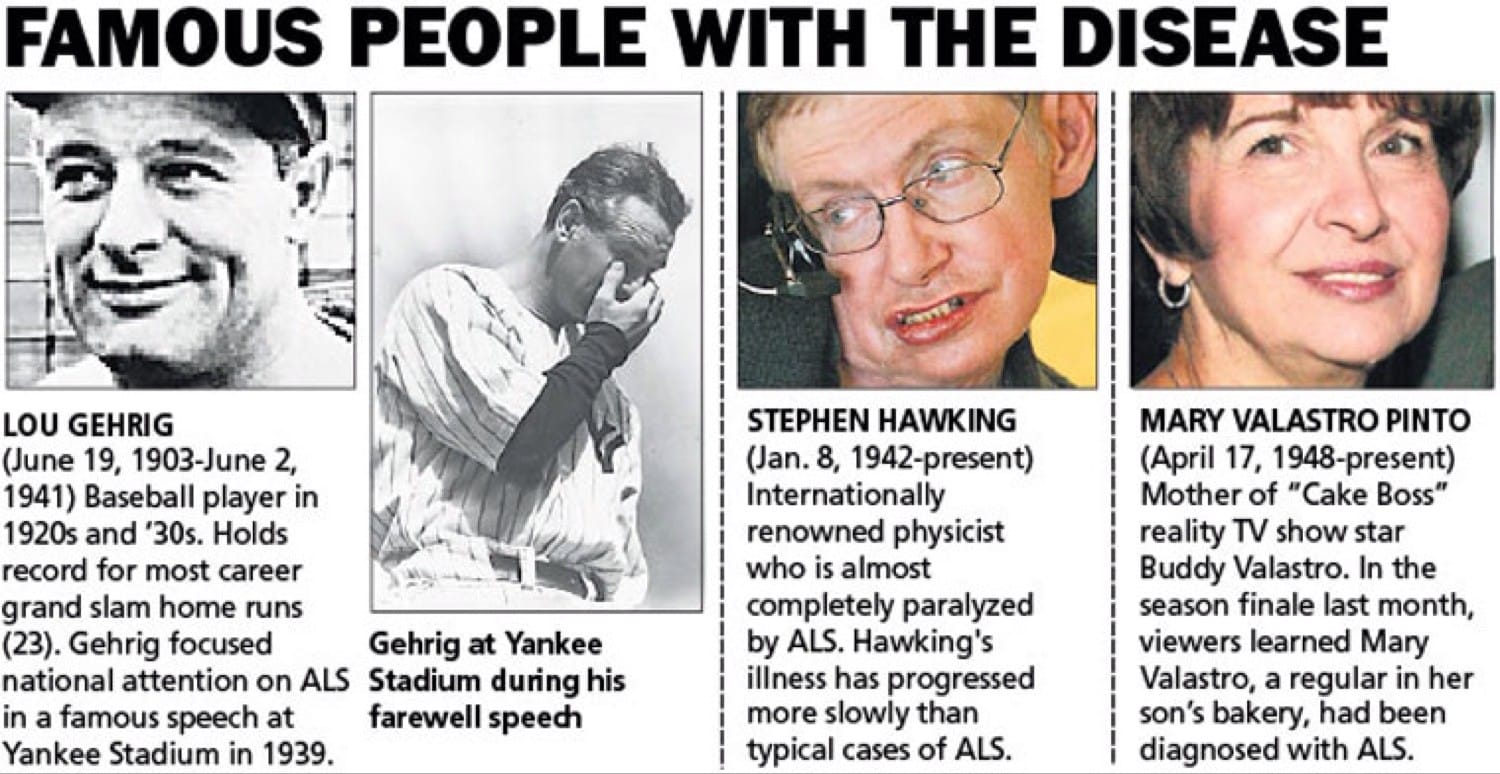Prepare to be mesmerized by the vibrant spectacle of the famed Indian festival filled with color, a kaleidoscope of traditions and joyous celebrations. Delve into the captivating lives and accomplishments of famous Venezuelans who have shaped their nation’s history and culture.
While Stephen Hawking’s incredible fight against ALS is widely known, he was not alone in facing this challenging disease. This article explores the lives of other notable figures who battled ALS, highlighting their resilience, contributions, and impact on raising awareness.
Inspiring Figures Who Lived with ALS
Lou Gehrig, whose name became synonymous with ALS, wasn’t the only prominent figure to confront this formidable disease. From scientists and politicians to musicians and athletes, many individuals navigated life in the public eye while grappling with the effects of ALS. Their stories offer a powerful testament to the human spirit.
Lou Gehrig: The Iron Horse and the Face of ALS
Lou Gehrig, the legendary New York Yankees first baseman known as “The Iron Horse,” became the face of ALS after his diagnosis in 1939. His emotional farewell speech at Yankee Stadium, a poignant moment in sports history, introduced the then-little-known disease to a wider audience. Gehrig’s legacy extends beyond baseball; his battle with ALS transformed public awareness, forever linking his name to the disease.
Beyond Baseball: ALS Across Diverse Fields
ALS affects people of all backgrounds and professions. Paul Cellucci, former governor of Massachusetts, dedicated his post-political life to raising ALS awareness. Jon Stone, one of the creative minds behind Sesame Street, brought joy to countless children while quietly battling the disease. The blues legend Lead Belly, whose music resonated with hardship, also faced ALS. These figures represent just a few of the diverse lives touched by this disease.
A Spectrum of Stories: Music, Sports, and Military Strategy
The impact of ALS extends across various fields. Charles Mingus, the influential jazz musician, continued to create music despite his diagnosis. Don Revie, an innovative English football manager, also faced this challenge. Ezzard Charles, a boxing champion known for his powerful punches, fought a different kind of battle outside the ring. Friedrich Paulus, a German field marshal, experienced another form of defeat following his surrender at Stalingrad. Each story highlights the broad reach of ALS.
Advocacy and Legacy: Raising Awareness and Inspiring Hope
Many prominent individuals with ALS used their platforms to advocate for research and support, leaving a lasting legacy. Their public visibility helped raise awareness, promote understanding, and inspire hope. Their efforts undoubtedly contributed to advancements in research and improved support for those affected by ALS.
Who is the Most Famous Person with ALS?
While Lou Gehrig remains the most widely associated figure with ALS, other notable individuals like Stephen Hawking, Roberta Flack, and Dennis Day also bravely faced this challenging disease. Determining the most famous person with ALS is subjective, but exploring the lives and impact of these figures offers valuable insights.
Lou Gehrig: A Name Synonymous with ALS
Lou Gehrig’s 1939 diagnosis brought ALS into the public consciousness. At the time, little was known about the disease. His experience played a crucial role in raising awareness and giving ALS its common name, “Lou Gehrig’s disease.”
Stephen Hawking: A Triumph of the Human Spirit
Stephen Hawking, the brilliant theoretical physicist, lived with ALS for over fifty years, defying the typical prognosis. His scientific contributions, made despite profound physical limitations, continue to inspire awe and wonder. Hawking’s life demonstrates the human spirit’s remarkable capacity to thrive even under the most challenging circumstances.
Roberta Flack and Dennis Day: Raising Awareness Across Fields
Roberta Flack’s recent ALS diagnosis highlights the indiscriminate nature of the disease within the music community. Dennis Day’s posthumous diagnosis underscores the diagnostic challenges sometimes associated with ALS.
The Human Side of ALS
These stories humanize the disease, illustrating its impact on individuals from all walks of life. Considering these figures emphasizes the importance of continued research, improved care, and unwavering support for those affected by ALS.
Can You Live 10 Years with ALS?
While the average ALS life expectancy is 2-5 years, 10%-20% of individuals live for 5-20 years, and some, like Stephen Hawking, for over 50. Various factors influence survival, including age at diagnosis, genetics, the rate of disease progression, respiratory function, and access to quality supportive care.
Understanding ALS Life Expectancy
The average lifespan doesn’t represent everyone’s experience. Some individuals live much shorter lives, while others live significantly longer. This variability makes it essential to consider individual factors rather than relying solely on averages.
Factors Influencing Survival
Several factors can influence how long someone lives with ALS. Age at diagnosis sometimes plays a role, with younger age potentially correlating with slower progression, although this is not always the case. Genetic factors are significant, particularly in familial ALS. However, even within families sharing the same genetic mutation, disease progression can vary greatly.
Perhaps the most significant factor is the rate of disease progression itself, which differs dramatically between individuals. Maintaining good respiratory function is critical, as respiratory issues are a common and serious complication. Access to high-quality, multidisciplinary care, including respiratory support, physical and occupational therapy, nutritional guidance, and psychological support, can significantly impact both length and quality of life.
Hope for the Future
Ongoing research offers hope for extending ALS survival. Emerging therapies, including gene therapy and stem cell treatments, aim to slow or even halt disease progression. While there are no guarantees, these advancements suggest a more promising future for those affected by ALS.
What are the 7 Stages of ALS?
While often described in stages, ALS progression is highly variable and personalized. The “7 stages” provide a general framework, but it’s essential to remember that each person’s journey is unique.
Understanding ALS Progression
The early stages of ALS may involve subtle symptoms like clumsiness, dropping objects, or occasional tripping. Weakness might start in a single hand or foot. Muscle twitches (fasciculations) and slurred speech (dysarthria) can also occur.
As ALS progresses, weakness spreads, making everyday tasks increasingly challenging. Assistive devices become crucial for maintaining independence. Eventually, swallowing (dysphagia) becomes difficult, often necessitating a gastrostomy (feeding tube). Respiratory muscles weaken, leading to shortness of breath and potential ventilator use.
The Importance of Individualized Care
The typical lifespan after diagnosis is 2-5 years, but some individuals live much longer. Stephen Hawking’s 55-year survival underscores this variability. Factors like age at diagnosis, genetic background, and access to supportive care all contribute to individual experiences.
Famous Figures and the Varied Trajectories of ALS
Lou Gehrig’s rapid decline contrasts sharply with Stephen Hawking’s extended lifespan. These contrasting experiences highlight the unpredictable nature of ALS and the importance of personalized care and support. While their stories raised public awareness, they also demonstrate how much we still don’t know about this complex disease. Ongoing research continues to explore the complexities of ALS, seeking to understand its causes and develop effective treatments.
- Georgia Platform: A Southern Strategy, 1850s - March 31, 2025
- How many weeks is 40 days: Quick Conversion Guide for Accurate Results - March 31, 2025
- How many feet is 300 meters? 984 Feet: Understand Length Conversions Easily - March 31, 2025

















2 thoughts on “Beyond Stephen Hawking: Famous Figures Who Battled ALS”
Comments are closed.